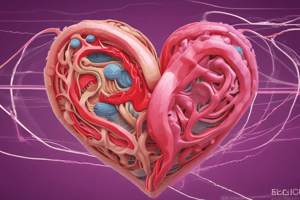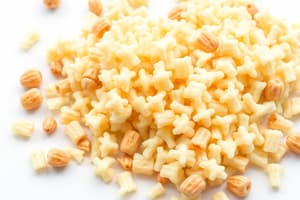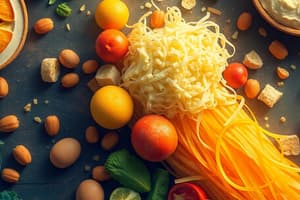Podcast
Questions and Answers
Which fatty acid is considered a monounsaturated fatty acid?
Which fatty acid is considered a monounsaturated fatty acid?
- Linoleic acid
- Stearic acid
- Linolenic acid
- Oleic acid (correct)
What is the main storage form of fats in the body?
What is the main storage form of fats in the body?
- Cholesterol
- Sterols
- Phospholipids
- Triglycerides (correct)
In which part of the fatty acid chain is the first double bond counted from?
In which part of the fatty acid chain is the first double bond counted from?
- Methyl end (correct)
- Middle
- Anywhere along the chain
- Carboxyl group end
Which type of fatty acid has the maximum number of hydrogens without carbon-carbon double bonds?
Which type of fatty acid has the maximum number of hydrogens without carbon-carbon double bonds?
Which enzyme breaks down maltose into glucose?
Which enzyme breaks down maltose into glucose?
What is the function of phospholipids in the body?
What is the function of phospholipids in the body?
Which type of fatty acids contain more than one double bond?
Which type of fatty acids contain more than one double bond?
Where does MOST of the digestion of fats occur in the digestive system?
Where does MOST of the digestion of fats occur in the digestive system?
Which enzyme is responsible for churning and mixing fat with water and acid in the stomach?
Which enzyme is responsible for churning and mixing fat with water and acid in the stomach?
Which type of fatty acids are absorbed directly into the blood without being repackaged?
Which type of fatty acids are absorbed directly into the blood without being repackaged?
Which component helps transport lipids into the intestinal cells or enterocytes in the small intestine?
Which component helps transport lipids into the intestinal cells or enterocytes in the small intestine?
What do chylomicrons primarily transport through the body?
What do chylomicrons primarily transport through the body?
Which of the following correctly describes how short and medium chain fatty acids enter circulation?
Which of the following correctly describes how short and medium chain fatty acids enter circulation?
What is the primary function of chylomicrons in the body?
What is the primary function of chylomicrons in the body?
Which lipoprotein is responsible for transporting cholesterol from the liver to peripheral tissues?
Which lipoprotein is responsible for transporting cholesterol from the liver to peripheral tissues?
What is the function of Very Low-Density Lipoproteins (VLDL) in the body?
What is the function of Very Low-Density Lipoproteins (VLDL) in the body?
Which type of lipoprotein is often referred to as 'good cholesterol'?
Which type of lipoprotein is often referred to as 'good cholesterol'?
Which type of fatty acid is recommended to be limited according to Health Canada?
Which type of fatty acid is recommended to be limited according to Health Canada?
What is the main component of proteins that differentiates one amino acid from another?
What is the main component of proteins that differentiates one amino acid from another?
Which amino acid is considered essential because the body cannot synthesize it in sufficient quantities?
Which amino acid is considered essential because the body cannot synthesize it in sufficient quantities?
How does protein synthesis occur?
How does protein synthesis occur?
What must dietary proteins supply to prevent protein breakdown?
What must dietary proteins supply to prevent protein breakdown?
Flashcards are hidden until you start studying
Study Notes
Lipids
- Lipids are not easily digested or absorbed due to their insolubility in water, with most digestion occurring in the small intestine.
- The process of lipid digestion involves:
- Mouth and salivary glands: melting hard fats, and lingual lipase secreted from sublingual salivary gland (slight hydrolysis for most fats).
- Stomach: churning action mixes fat with water and acid, and gastric lipase breaks down a small amount of fat.
- Small intestine: bile emulsifies fat, and pancreatic and intestinal lipase break down emulsified fat further (e.g., triglycerides à 3 fatty acids and glycerol).
- Absorption of lipids involves:
- Enterocyte (intestinal cell) absorbs digestive products, including cholesterol, free fatty acids, monoacylglyceride, or monoglyceride.
- Assistance of micelle (combination of proteins, monoglycerides, and fatty acids) helps transport lipids into the intestinal cells or enterocytes.
- Once absorbed, micelle is disassembled, and absorbed products are treated differently:
- Medium and short-chain fatty acids are absorbed directly into the blood, with solubility increased by albumin (protein).
- Phospholipids, cholesterol, and resynthesized triglycerides are repackaged with protein into chylomicrons (lipoprotein) in the endoplasmic reticulum (ER) of enterocyte.
- Transportation of lipid products differs:
- Short and medium-chain fatty acids move through the enterocyte and enter circulation via capillaries, riding on albumin, then carried to the liver.
- Chylomicrons are too large to fit through the pores of the capillaries, so they are transported through the lymphatic system.
Lipoproteins
- There are four types of lipoproteins, which differ in size and density, depending on the proportion of lipids and proteins they carry:
- Chylomicrons: transport dietary lipids from the intestine to other parts of the body.
- Very Low-Density Lipoproteins (VLDL): transport endogenous (produced by the body) triglycerides from the liver to peripheral (adipose and muscle) tissues.
- Low-Density Lipoproteins (LDL) or "bad cholesterol": transport cholesterol from the liver to peripheral tissues.
- High-Density Lipoproteins (HDL) or "good cholesterol": remove excess cholesterol from the bloodstream and transport it to the liver for excretion.
Storage and Health Recommendations
- Adipose tissue is an efficient storage site for triglycerides, with virtually unlimited storage capacity.
- Health Canada recommends:
- 20-35% of daily caloric intake from lipids.
- Limiting Saturated Fatty Acids (SFA), Trans Fatty Acids (TFA), and dietary cholesterol.
Proteins
- Proteins are large complex molecules found in the cells of all living things, composed of strands of amino acids.
- Amino acids are the building blocks of proteins, with 20 different types, including:
- 9 essential amino acids (indispensable) that cannot be synthesized by the body.
- 11 non-essential amino acids that can be synthesized by the body.
- Protein synthesis involves:
- Condensation (removal of water) to form a peptide bond.
- Formation of a dipeptide or polypeptide chain.
Protein Quality and Digestibility
- Protein quality is determined by its ability to provide all essential amino acids.
- Digestibility depends on the protein source and other foods consumed together.
- Amino acid composition is critical to prevent protein breakdown.
- Mutual supplementation involves obtaining complete amino acid requirements from two or more incomplete protein sources.
- Complementary proteins are two or more proteins whose amino acids complement each other.
Fibers and Added Sugars
- Dietary fiber recommendations are about 14 grams per 1000 kcal/day.
- Added sugars are defined as sugars and syrups added to foods during processing or preparation.
- The World Health Organization recommends limiting added sugars to 10% or less of total daily energy intake.
Studying That Suits You
Use AI to generate personalized quizzes and flashcards to suit your learning preferences.



